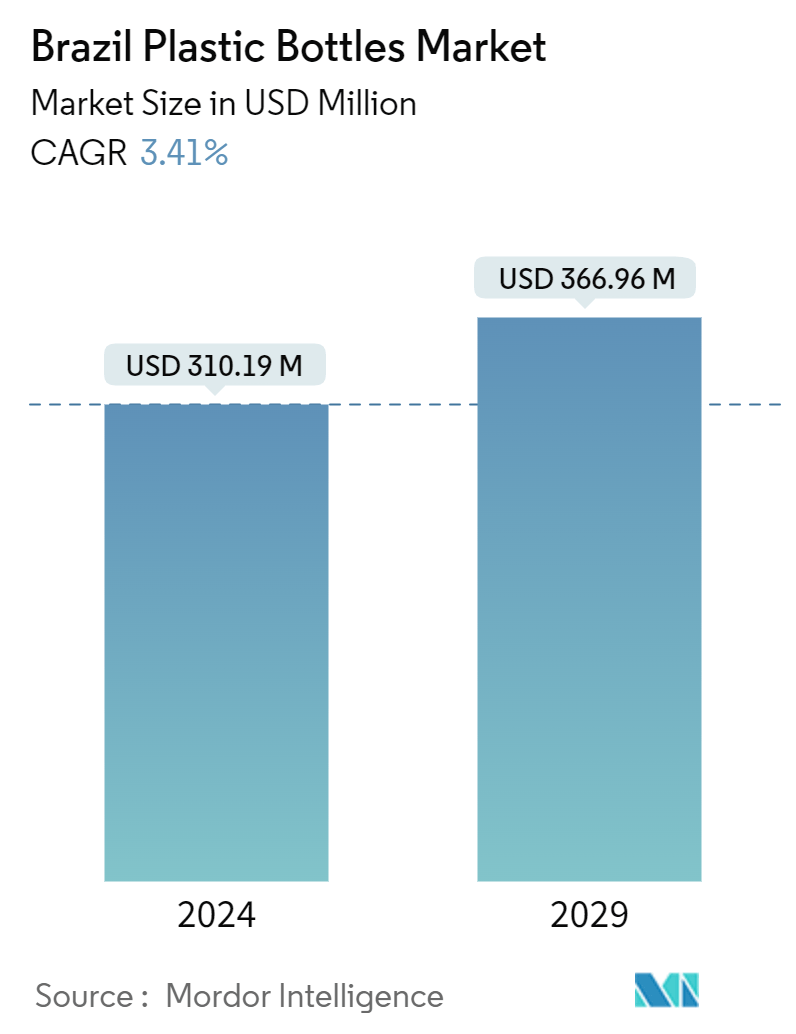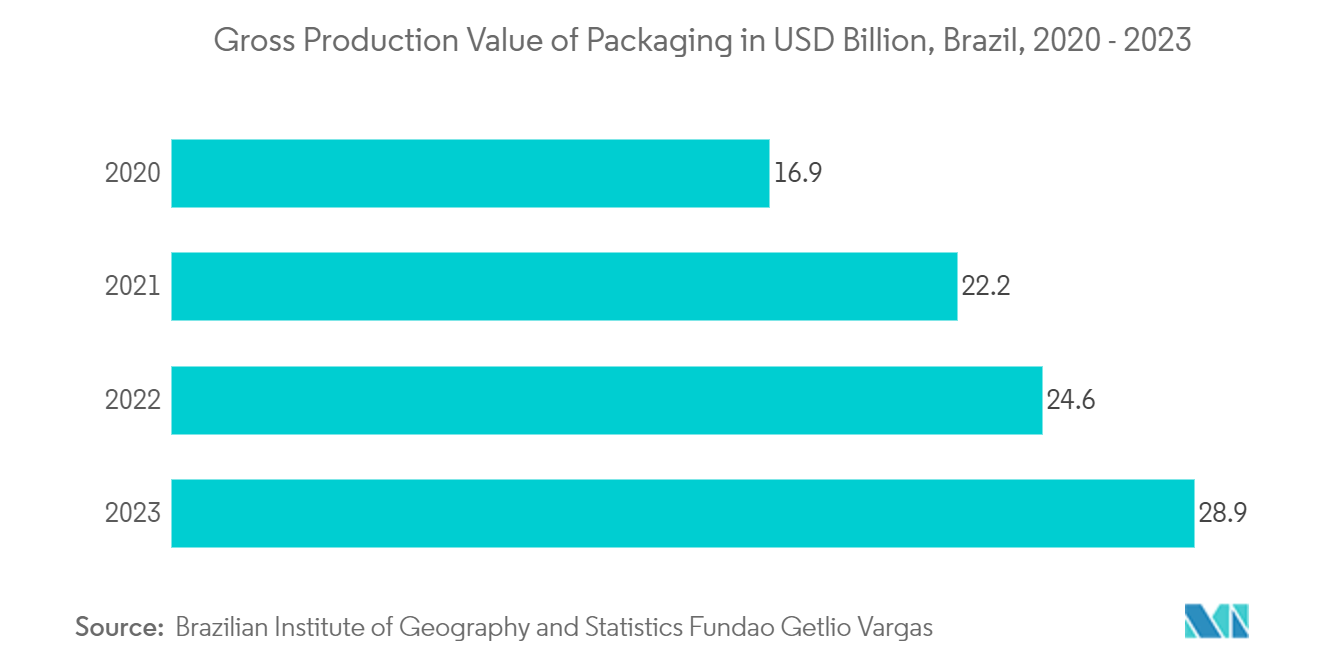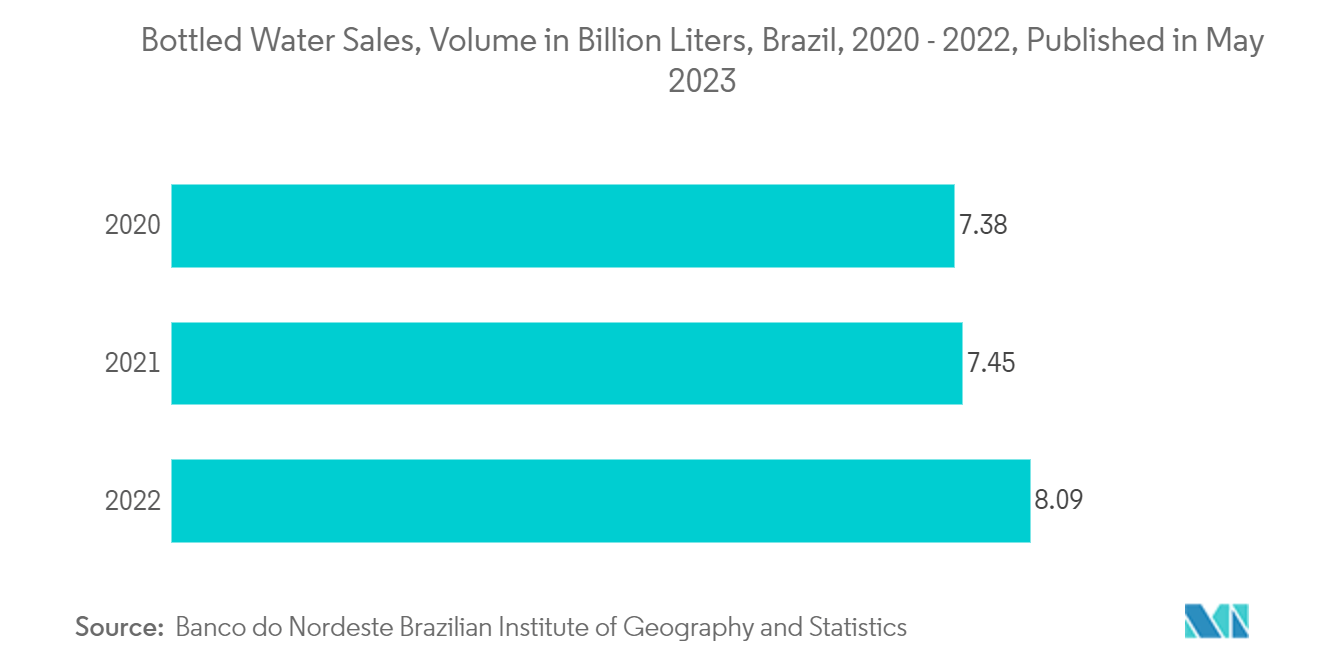Brazil Plastic Bottles Market Size

| Study Period | 2019 - 2029 |
| Base Year For Estimation | 2023 |
| Market Size (2024) | USD 310.19 Million |
| Market Size (2029) | USD 366.96 Million |
| CAGR (2024 - 2029) | 3.41 % |
| Market Concentration | Low |
Major Players.webp)
*Disclaimer: Major Players sorted in no particular order |
Brazil Plastic Bottles Market Analysis
The Brazil Plastic Bottles Market size is estimated at USD 310.19 million in 2024, and is expected to reach USD 366.96 million by 2029, growing at a CAGR of 3.41% during the forecast period (2024-2029). In terms of production volume, the market is expected to grow from 335.05 thousand tonnes in 2024 to 393.23 thousand tonnes by 2029, at a CAGR of 3.25% during the forecast period (2024-2029).
- Plastic packaging has gained significant popularity among consumers in Brazil compared to other materials due to its lightweight and durable nature, which enhances ease of handling and transportation. Major manufacturers also prefer plastic packaging because of its lower production costs and versatility in design. Furthermore, the introduction of advanced polymers like polyethylene terephthalate (PET) and high-density polyethylene (HDPE) has substantially expanded the applications for plastic bottles across various industries, including food and beverage, personal care, and household products. The market has experienced a notable increase in demand for PET bottles, driven by their recyclability, clarity, and barrier properties. This trend is further supported by the growing consumer awareness of environmental issues and the subsequent demand for more sustainable packaging solutions.
- Plastic bottles and containers, primarily made of polyethylene terephthalate, polypropylene, and polyethylene, are widely used due to their lightweight properties and recyclability. These characteristics make plastic the preferred choice among end-users in various industries, including food and beverage, personal care, and household products. The cost-effectiveness of plastic materials is a significant factor driving their adoption. In addition, the increasing global consumption of packaged and processed foods and the growing demand for bottled beverages are expected to fuel market growth. The versatility of plastic packaging, its ability to extend product shelf life, and its convenience for consumers further contribute to its popularity.
- Brazil has experienced improved economic growth and significant demographic changes that have influenced the region's development. The expansion of organized retail, including supermarkets and hypermarkets, has increased the demand for plastic bottles. These outlets require extensive packaging to cater to diverse consumer needs, driving overall market growth. The trade scenario has evolved in recent years. As imports and exports in the region have grown, there has been a corresponding increase in demand for packaging that meets international standards. This demand is driven by the necessity for plastic bottles to comply with global packaging requirements and ensure the quality of exported products.
- An expanding array of applications across various regional industries drives the market's growth. In the pharmaceutical sector, plastic bottles are a dependable packaging choice for tablets, syrups, and capsules, thanks to their moisture-resistant properties that ensure product stability. For instance, Berry Global Healthcare is launching a comprehensive solution to help clients tap into the surging demand for child-resistant (CRC) and tamper-evident (TE) packaging in the pharmaceutical and herbal sectors, specifically for syrups and liquid medicines. Leveraging its extensive design and technical expertise in healthcare, the company offers a diverse range of bottle and closure solutions tailored to market needs.
- While Brazil has not implemented a nationwide ban, key local governments such as the State of Rio de Janeiro and the City of São Paulo have adopted bans on plastic packaging and other single-use plastic products. Companies have begun to adapt quickly, working to measure plastic footprints, introduce new products with recycled plastic (rPET), set ambitious yet achievable targets, and implement changes to packaging supply chains. For instance, Valgroup has acquired the PET bottle recycling activity of 3 Rios Fibras e Resinas in Poços de Caldas, Minas Gerais. The company is investing in expansion, increasing its installed capacity to produce food-grade rPET (recycled PET resin). This recycling process, known as bottle-to-bottle, transforms post-consumer PET bottles into new ones ready for filling. Valgroup's PET recycling plants, located in Brazil, Mexico, and Spain, process a total of 145,000 tons of post-consumption recycled resin annually.
Brazil Plastic Bottles Market Trends
Polyethylene Terephthalate (PET) segment to Hold Significant Market Share
- PET has emerged as a crucial packaging material for bottle manufacturers nationwide. The increasing use of lightweight resins with high strength, toughness, abrasion resistance, heat resistance, low creep at elevated temperatures, and good chemical resistance makes PET resins ideal for bottle and container production. These properties allow manufacturers to create durable and versatile packaging solutions that meet various industry requirements.
- The trend towards lightweight products is cost-effective and helps manufacturers gain a competitive advantage in the market. Companies can lower production costs and improve profit margins by reducing material usage without compromising performance. In addition, lightweight PET bottles contribute to reduced transportation costs and environmental impact, aligning with growing consumer demand for sustainable packaging options.
- Furthermore, PET plastic bottles are increasingly replacing glass bottles due to their lightweight and durable nature. These bottles provide reusable packaging for mineral water and other beverages, enabling more cost-effective transportation. PET's transparency and inherent CO2 barrier properties make it suitable for various applications and allow easy molding into bottles or different shapes. The properties of PET can be enhanced with additives such as colorants, UV blockers, and oxygen barriers/scavengers to create bottles tailored to specific brand requirements.
- PET has become a crucial packaging material among bottle manufacturers across the region. Brazil's growing packaging industry has contributed to this trend. In 2023, Brazil's packaging industry's gross production value reached USD 28.9 billion, marking a substantial increase from the previous year's value of USD 24.6 billion.
- This growth can be attributed to several factors, including increased consumer demand for packaged goods, advancements in packaging technology, and the expansion of e-commerce. The rise in PET usage is particularly notable in the beverage sector, where its lightweight properties and recyclability make it an attractive option for manufacturers. In addition, the food and personal care industries have also seen an uptick in PET packaging adoption, further driving the overall growth of the packaging industry in Brazil.
- Sustainable packaging solutions have gained prominence in Brazil due to increasing consumer awareness of eco-friendly packaging's environmental benefits. PET has become an essential resin in developing sustainable packaging materials because of its recyclability and potential for circularity. The capacity to collect, process, and transform used PET products into new packaging materials offers a significant opportunity to reduce reliance on virgin resources and mitigate environmental waste.
- The future of PET recycling in Brazil is closely tied to technological advancements that enhance efficiency, cost-effectiveness, and environmental sustainability. Improved methods for collecting, processing, and transforming used PET products into new packaging materials offer significant opportunities to reduce reliance on virgin resources and mitigate environmental waste.
- These advancements may include more sophisticated sorting technologies, enhanced chemical recycling processes, and innovative packaging designs that facilitate easier recycling. As Brazil continues to focus on sustainable practices, the PET recycling industry is expected to see increased investment in research and development and supportive government policies to encourage recycling initiatives and circular economy principles.

Packaged Bottled Water is Expected to Witness Significant Growth
- PET bottles dominate the water packaging market compared to glass and other plastic bottles due to their durability and recyclability. The market trend indicates a growing preference for PET as a water packaging medium, driven by its lightweight nature, durability, and cost-effectiveness. This shift toward PET bottles is observed across various segments of the bottled water industry, including still, sparkling, and flavored waters.
- Manufacturers are increasingly adopting PET packaging solutions to meet consumer demands for convenience and sustainability. In addition, advancements in PET bottle design and manufacturing processes have further enhanced their appeal, allowing for improved barrier properties and reduced material usage while maintaining structural integrity.
- Pet bottles can be molded into various shapes to accommodate packaging trends and labeling requirements. This flexibility allows manufacturers to create unique, eye-catching designs that appeal to consumers and stand out on store shelves. Plastic's toughness and lightweight nature make bottled water easy to transport, reducing fuel costs and lower carbon emissions than heavier bottle materials. This advantage extends throughout the supply chain, from production facilities to distribution centers and retail locations, contributing to overall operational efficiency and environmental sustainability in the bottled water industry in Brazil,
- The consumption of bottled water is increasing across Brazil due to population growth and lifestyle changes. This trend is creating demand for various bottle formats that are lightweight, portable, and easily stored while meeting regulatory requirements and addressing consumer preferences for sustainability. The growing awareness of health and wellness among Brazilians has also contributed to rising bottled water consumption as consumers seek convenient and safe hydration options.
- In addition, the country's diverse climate and occasional water quality issues in certain regions have further boosted the demand for bottled water. In 2022, the annual sales volume of bottled water in Brazil reached approximately 8.1 billion liters, up from 7.45 billion liters in the previous year. This significant increase reflects the market's robust growth and the shifting consumer preferences toward packaged water products. The bottled water industry in Brazil continues to innovate, offering a range of options, including mineral water, purified water, and flavored water, to cater to diverse consumer tastes and needs.
- Governments across regions are implementing various initiatives to recycle single-use plastic bottles. These include encouraging consumers to refill reusable bottles, promoting the use of biodegradable or recycled PET for bottle manufacturing, developing eco-friendly designs, and establishing dedicated councils for recycling plastic bottles from various end-users. Manufacturers in the region are investing in innovations to produce water bottles that comply with government recycling regulations and align with their own sustainability goals.

Brazil Plastic Bottles Industry Overview
The Brazilian plastic bottle market is fragmented, with several global and regional players, such as ALPLA Group, Amcor GMBH, Velaplast, and others, vying for attention in a contested market space. This market is characterized by low product differentiation, growing levels of product penetration, and high levels of competition. Significant investment in research and development activities and strategic mergers and acquisitions have allowed the companies to gain a strong foothold in the market.
• May 2024 - ALPLA, a specialist in plastic packaging, is introducing a safe, affordable, and sustainable recyclable PET wine bottle. Weighing just an eighth of a traditional glass bottle, this innovation cuts the carbon footprint by as much as 50% and offers potential cost savings of up to 30%. The bottle can be produced entirely from recycled PET (rPET). Currently, the packaging solution is available in 0.75-liter and 1-liter sizes.
• April 2024 - Amcor, a global player in packaging solutions, has unveiled a one-liter carbonated soft drink (CSD) bottle crafted entirely from post-consumer recycled (PCR) polyethylene terephthalate (PET) material.
Brazil Plastic Bottles Market Leaders
-
ALPLA Group
-
Sidel Group
-
Berry Global Inc.
-
Amcor Group
-
Velaplast
*Disclaimer: Major Players sorted in no particular order
.webp)
Brazil Plastic Bottles Market News
- November 2023 - Sidel's newly introduced PET bottle aims to give liquid dairy manufacturers a heightened competitive edge. Tailored for products like drinking and probiotic yogurts, this compact bottle accommodates capacities ranging from 65ml to 150ml. It's optimized for both ambient and cold-chain processes. Beyond dairy, the bottle is also apt for applications in the juice, nectar, soft drinks, isotonic, and tea sectors.
- August 2023 - Indorama Ventures Public Company Limited, a leading global producer of recycled Polyethylene Terephthalate (PET) resin, has successfully expanded its recycling facility in Brazil. This expansion was facilitated by a 'Blue Loan' from the International Finance Corporation (IFC), affiliated with the World Bank. Situated in Juiz de Fora, Minas Gerais, Brazil, the recycling facility is ramping up its production capacity from 9,000 tons to an impressive 25,000 tons annually. This increase focuses on PET derived from post-consumer recycled (PET-PCR) material. This initiative aligns with Indorama Ventures' Vision 2030, underscoring its commitment to sustainability. As part of this vision, the company has earmarked a substantial USD 1.5 billion investment to boost its recycling capacity to handle 50 billion PET bottles annually by 2025.
Brazil Plastic Bottles Market Report - Table of Contents
1. INTRODUCTION
- 1.1 Study Assumption and Market Defintion
- 1.2 Scope of the Study
2. RESEARCH METHODOLOGY
3. EXECUTIVE SUMMARY
4. MARKET INSIGHTS
- 4.1 Market Overview
-
4.2 Industry Attractiveness - Porter's Five Forces Analysis
- 4.2.1 Bargaining Power of Suppliers
- 4.2.2 Bargaining Power of Buyers
- 4.2.3 Threat of New Entrants
- 4.2.4 Threat of Substitutes
- 4.2.5 Intensity of Competitive Rivalry
- 4.3 Industry Value Chain Analysis
5. MARKET DYNAMICS
-
5.1 Market Drivers
- 5.1.1 Rising Popularity of Lightweight Packaging Solutions
-
5.2 Market Restraints
- 5.2.1 Growing Environmental Concerns over the Use of Plastic
-
5.3 Trade Scenario
- 5.3.1 EXIM Data
- 5.3.2 Trade Analysis
6. MARKET SEGMENTATION
-
6.1 By Resin
- 6.1.1 Polyethylene (PE)
- 6.1.2 Polyethylene Terephthalate (PET)
- 6.1.3 Polypropylene (PP)
- 6.1.4 Other Resins (Polystyrene, PVC, Polycarbonate, etc.)
-
6.2 By End-use Industries
- 6.2.1 Food
- 6.2.2 Beverage
- 6.2.2.1 Bottled Water
- 6.2.2.2 Carbonated Soft Drinks
- 6.2.2.3 Alcoholic Beverages
- 6.2.2.4 Juices & Energy Drinks
- 6.2.2.5 Other Beverages
- 6.2.3 Pharmaceuticals
- 6.2.4 Personal Care & Toiletries
- 6.2.5 Industrial
- 6.2.6 Household Chemicals
- 6.2.7 Paints & Coatings
- 6.2.8 Other End-use Industries
7. COMPETITIVE LANDSCAPE
-
7.1 Company Profiles*
- 7.1.1 ALPLA Group
- 7.1.2 Amcor Group
- 7.1.3 Velaplast
- 7.1.4 Sidel Group
- 7.1.5 Berry Global Inc.
- 7.1.6 Graham Packaging
- 7.1.7 Gerresheimer AG
- 7.1.8 KHS GmbH
- 7.1.9 VALGROUP
- 7.1.10 Weener Plastics Group B.V.
- 7.2 Heat Map Analysis
- 7.3 Competitor Analysis - Emerging vs. Established Players
8. RECYCLING & SUSTAINABILITY LANDSCAPE
9. FUTURE OUTLOOK
** Subject To AvailablityBrazil Plastic Bottles Industry Segmentation
• The scope of the study characterizes the plastic bottles market based on the raw material of the product, including PP, PE, PET, and other raw materials used across various end-user industries such as food, pharmaceuticals, beverage, cosmetics, and toiletries, and more across various countries. The research also examines underlying growth influencers and significant industry vendors, all of which help to support market estimates and growth rates throughout the anticipated period. The market estimates and projections are based on the base year factors and arrived at top-down and bottom-up approaches.
• The Brazilian plastic bottles market is segmented by resin (polyethylene (PE), polyethylene terephthalate (PET), polypropylene (PP), and other resins [polystyrene, PVC, polycarbonate, etc.]) and by end-use industries (food, beverage [bottled water, carbonated soft drinks, alcoholic beverages, juices and energy drinks and other beverages], pharmaceuticals, personal care and toiletries, household chemicals, paints and coatings, and other end-use industries). The market sizes and forecasts are provided in terms of value (USD) and volume (Tonnes) for all the above segments.
| By Resin | Polyethylene (PE) | |
| Polyethylene Terephthalate (PET) | ||
| Polypropylene (PP) | ||
| Other Resins (Polystyrene, PVC, Polycarbonate, etc.) | ||
| By End-use Industries | Food | |
| Beverage | Bottled Water | |
| Carbonated Soft Drinks | ||
| Alcoholic Beverages | ||
| Juices & Energy Drinks | ||
| Other Beverages | ||
| Pharmaceuticals | ||
| Personal Care & Toiletries | ||
| Industrial | ||
| Household Chemicals | ||
| Paints & Coatings | ||
| Other End-use Industries |
Brazil Plastic Bottles Market Research FAQs
How big is the Brazil Plastic Bottles Market?
The Brazil Plastic Bottles Market size is expected to reach USD 310.19 million in 2024 and grow at a CAGR of 3.41% to reach USD 366.96 million by 2029.
What is the current Brazil Plastic Bottles Market size?
In 2024, the Brazil Plastic Bottles Market size is expected to reach USD 310.19 million.
Who are the key players in Brazil Plastic Bottles Market?
ALPLA Group, Sidel Group, Berry Global Inc., Amcor Group and Velaplast are the major companies operating in the Brazil Plastic Bottles Market.
What years does this Brazil Plastic Bottles Market cover, and what was the market size in 2023?
In 2023, the Brazil Plastic Bottles Market size was estimated at USD 299.61 million. The report covers the Brazil Plastic Bottles Market historical market size for years: 2019, 2020, 2021, 2022 and 2023. The report also forecasts the Brazil Plastic Bottles Market size for years: 2024, 2025, 2026, 2027, 2028 and 2029.
Brazil Plastic Bottles Industry Report
Statistics for the 2024 Brazil Plastic Bottles market share, size and revenue growth rate, created by Mordor Intelligence™ Industry Reports. Brazil Plastic Bottles analysis includes a market forecast outlook for 2024 to 2029 and historical overview. Get a sample of this industry analysis as a free report PDF download.



